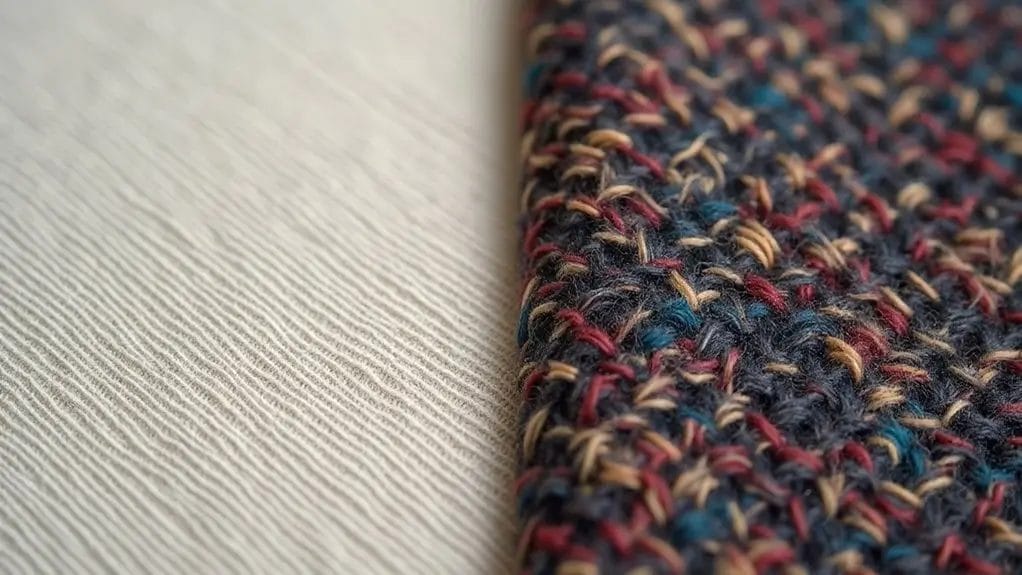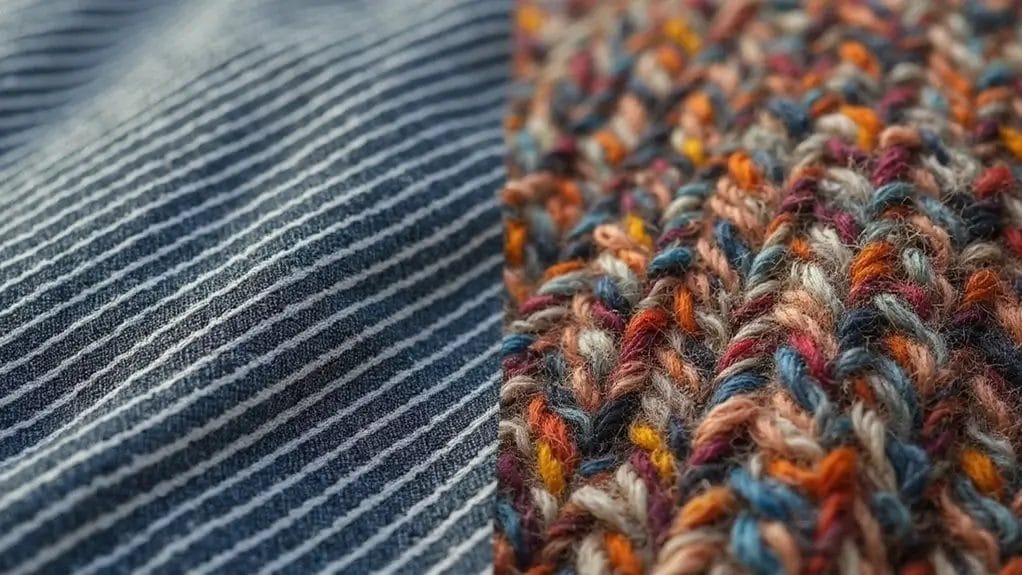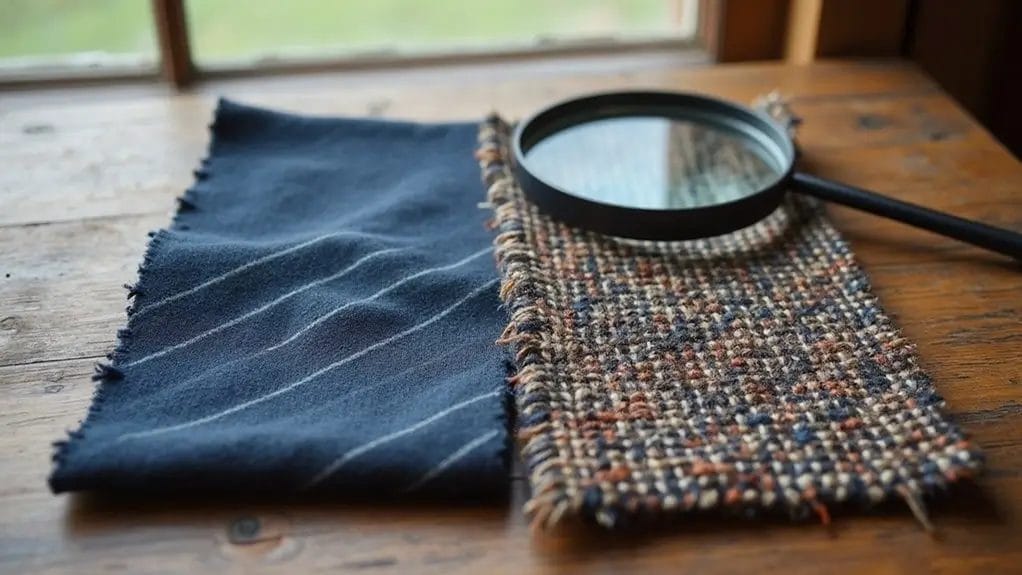When you're maneuvering through the world of textile manufacturing, you'll find that twill and tweed stand out as two distinct fabric champions, each with its own manufacturing legacy and performance attributes. While both fabrics have earned their place in fashion and furnishings, their construction methods, fiber compositions, and end-use applications couldn't be more different. Understanding these key distinctions will help you make informed decisions about which fabric best suits your specific requirements.
Key Takeaways
- Twill is defined by its diagonal weave pattern, while tweed is characterized by its multicolored, textured appearance using blended wool fibers.
- Twill creates a smooth, ribbed surface ideal for everyday wear, whereas tweed has a rougher, open texture with visible flecks.
- Twill fabrics are commonly used in denim and chinos, while tweed is traditionally used for outerwear and formal suiting.
- Twill's construction focuses on weave technique for durability, while tweed emphasizes fiber blending and pattern complexity for warmth.
- Twill offers natural wrinkle resistance through its weave, while tweed provides natural weather resistance through dense wool construction.
What is Twill?

Twill is a fundamental textile weave characterized by its distinctive diagonal pattern created when weft threads pass over one or more warp threads in a repeated, progressive manner.
You'll recognize twill's signature ribbed appearance in fabrics ranging from denim and chino to gabardine, where the diagonal lines can run either left-to-right or right-to-left, creating what's known as an S-twill or Z-twill respectively.
Due to its tight weave structure and durability, you'll find twill extensively used in workwear, upholstery, and fashion garments where strength and drape are essential requirements.
Definition and Characteristics
A distinct weaving pattern characterizes twill, featuring diagonal parallel ribs created by passing weft yarns over one or more warp yarns, then under two or more warp yarns in a regular sequence.
You'll find twill's signature characteristics in these key features:
- Strong, durable fabric structure due to the tight, diagonal weave pattern
- Higher thread count than plain weaves, offering superior drape and texture
- Distinctive diagonal lines running at 45-degree angles across the fabric
- Natural wrinkle resistance thanks to the interlaced yarn configuration
- Excellent ability to hide stains due to the complex surface texture
This weaving technique creates a fabric that's both functional and aesthetically pleasing, making it popular in applications from denim to upholstery.
Common Uses of Twill
Three major sectors dominate twill's commercial applications: apparel manufacturing, home furnishings, and industrial textiles.
You'll find this durable type of fabric in everyday clothing like jeans, chinos, and workwear uniforms. The distinctive diagonal weave makes twill cloth particularly resistant to wear and tear, ideal for upholstery, drapery, and heavy-duty slipcovers in home décor.
In industrial settings, twill serves as a reliable material for protective gear, equipment covers, and specialized work garments. Its versatility extends to accessories like bags, backpacks, and luggage, where its strength and aesthetic appeal make it a preferred choice for manufacturers.
What is Tweed?

Tweed is a rugged woolen fabric characterized by its distinctive multicolored, textured appearance created through a traditional twill or plain weave using complex yarn combinations.
You'll find tweed woven from wool fibers that have been color-blended before spinning, often incorporating flecks of different hues and featuring patterns such as herringbone, check, or houndstooth.
The fabric's dense construction and moisture-resistant properties make it ideal for outerwear, suiting, and upholstery, particularly in traditional Scottish and Irish garment manufacturing.
Definition and Characteristics
From its origins in Scotland's rugged Outer Hebrides, traditional tweed fabric consists of a sturdy woolen textile characterized by its distinctive multicolored, textured weave.
You'll find tweed's unique characteristics stem from its complex construction and raw materials:
- Woven using multiple colored yarns in various weights and textures
- Features a rough, open texture with visible flecks and slubs
- Incorporates complex patterns like herringbone, checks, and diagonal twill variations
- Traditionally crafted from virgin wool with high twist yarn counts
- Processed through waulking (wet finishing) to create a dense, weather-resistant cloth
These elements combine to create tweed's signature robustness and visual depth that's distinct from basic twill weaves.
Common Uses of Tweed
Today's finest bespoke tailoring establishments and heritage fashion houses continue to rely on tweed for its exceptional versatility and enduring appeal.
You'll find this robust wool fabric mainly in outerwear like hunting jackets, country sports attire, and sophisticated overcoats. It's particularly favored for creating structured blazers and suits that exude rustic elegance.
The dense weave and distinctive texture of tweed make it ideal for accessories that style well with formal and casual wear - from newsboy caps and flat caps to messenger bags and portfolio cases.
You'll also see tweed incorporated into home furnishings, upholstery, and contemporary designer collections.
Key Differences: Twill vs Tweed

When comparing twill and tweed, you'll notice three primary distinctions in their fundamental characteristics.
The first key difference lies in their construction - twill's distinctive diagonal weave pattern contrasts sharply with tweed's complex yarn-dyed patterns and characteristically rough, open weave structure.
These fabrics further differentiate themselves through their weight profiles and aesthetic presentations, with twill typically offering a smoother, more fluid drape compared to tweed's robust, textural appearance that's achieved through its unique yarn combinations and specialized finishing processes.
Weave and Texture
The fundamental distinction between twill and tweed lies in their construction methods and resulting textures.
- Twill has a distinctive diagonal weave pattern created by floating weft yarns over two or more warp yarns.
- Tweed features a complex, irregular weave incorporating multiple colored yarns and often flecked textures.
- You'll notice twill's smooth, uniform feel with its characteristic ribbed surface that runs at a 45-degree angle.
- Tweed's surface is characterized by a rougher, more robust texture with visible yarn variations.
- While twill maintains a consistent pattern throughout, tweed's texture varies due to its multi-colored yarn combinations and specialized weaving techniques.
Weight and Warmth
Beyond their distinct weave patterns, twill and tweed fabrics exhibit noticeably different characteristics in weight and thermal properties.
You'll find twill typically offers a lighter weight construction, with most varieties ranging from 7-12 ounces per yard. This makes it versatile for year-round wear.
In contrast, traditional tweeds, especially Harris tweed, can make garments considerably heavier, often weighing 16-20 ounces per yard.
The weight difference directly impacts their thermal properties. Twill's lighter construction provides moderate warmth, suitable for shifting weather.
Tweed's dense, textured weave creates superior insulation, making it ideal for cold-weather protection while maintaining excellent breathability.
Aesthetic Appeal
Visual distinctiveness between twill and tweed creates markedly different aesthetic signatures in finished garments.
You'll notice twill's characteristic diagonal ribs create a smooth, refined surface that's perfect for sophisticated applications.
- Twill offers a clean, uniform appearance with subtle diagonal lines
- Tweed showcases complex color variations through flecked yarn blends
- Twill maintains consistent patterning across its surface
- Tweed displays rustic character with visible texture and depth
- Twill's range stays monochromatic while tweed embraces multicolored patterns
These contrasting visual elements directly influence each fabric's end use, with twill favoring sleek professional wear and tweed excelling in country-inspired fashion and outerwear.
Frequently Asked Questions
Can Twill and Tweed Fabrics Be Blended Together in One Garment?
You can combine twill's diagonal weave with tweed's textured yarns in a single garment. The twill structure serves as your base fabric, while tweed elements can be integrated through patches or panels.
Which Fabric Is More Environmentally Sustainable, Twill or Tweed?
You'll find tweed's generally more eco-friendly due to its natural wool composition and local sourcing. However, twill's sustainability varies based on fiber content - organic cotton twill's more sustainable than synthetic-based twill constructions.
Are Twill and Tweed Equally Suitable for People With Sensitive Skin?
You'll find twill's tight, uniform weave is typically gentler on sensitive skin, while tweed's coarser fibers and looser construction may cause irritation. Twill's smooth diagonal wales offer superior dermatological comfort.
What Are the Best Methods for Storing Twill and Tweed Clothing?
Store your twill garments flat to prevent diagonal weave distortion. For tweed, use cedar hangers and breathable covers. You'll want to brush both periodically and maintain moderate humidity to preserve fiber integrity.
How Do Twill and Tweed Compare in Terms of Price Range?
You'll find basic twill weaves typically cost $15-30/yard, while artisanal tweeds command $40-100/yard. Premium Harris Tweed and designer twills can reach $150+/yard due to their specialized manufacturing processes.
Conclusion
Understanding these fabrics' distinct properties equips you with essential manufacturing insights. You'll find twill's 2/1 or 2/2 diagonal weave structure delivers superior tensile strength and drapeability, while tweed's complex woolen yarns and varied floats create thermal retention and textural depth. When specifying materials, consider twill for high-wear applications requiring durability, and opt for tweed when thermal insulation and traditional textile aesthetics are paramount manufacturing objectives.


0 comments